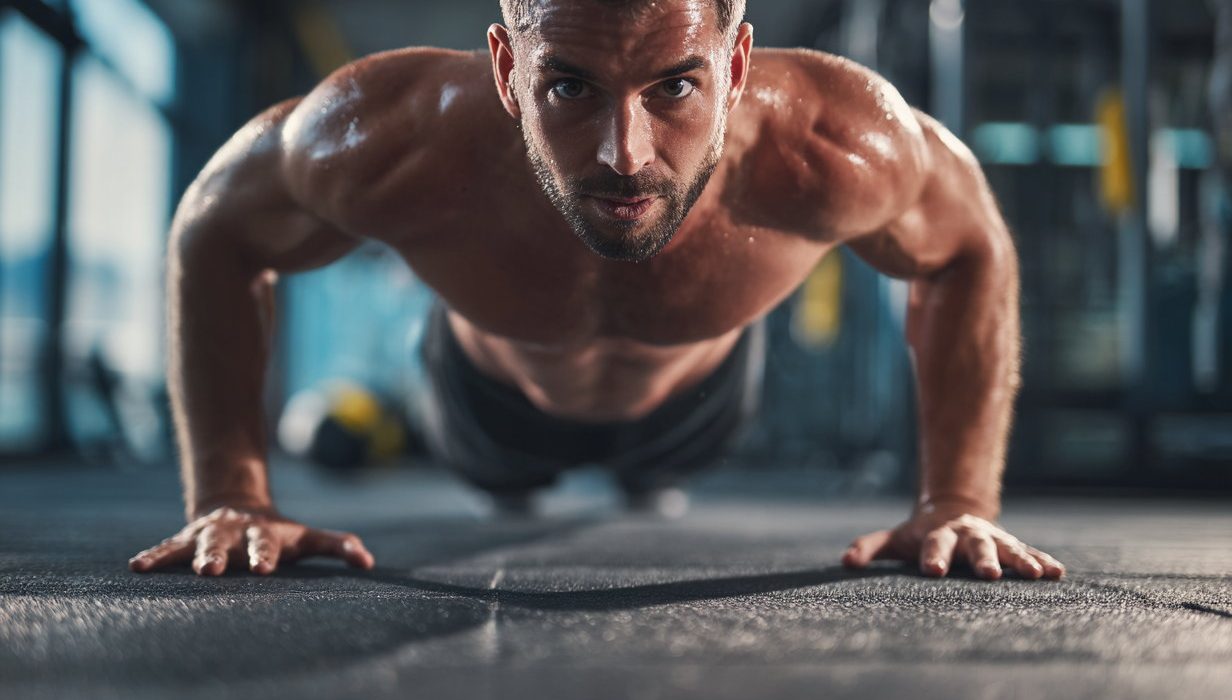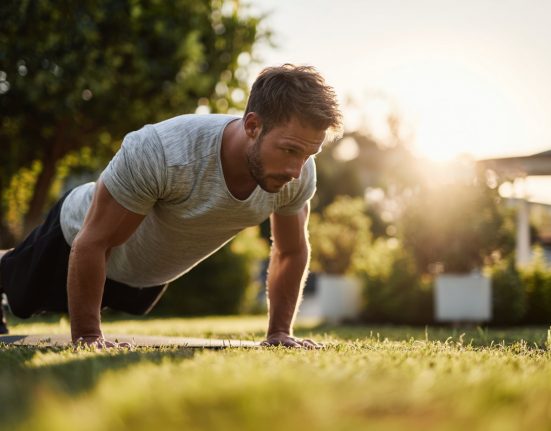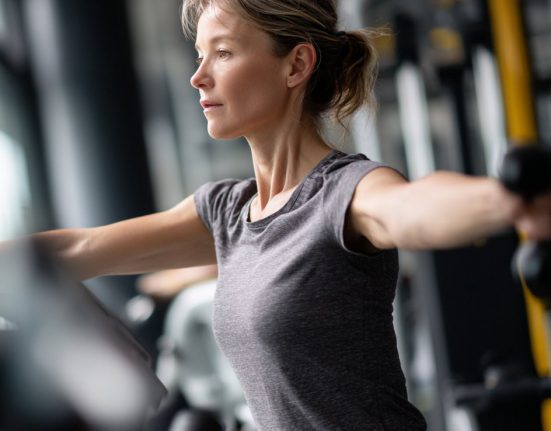Want muscle gains but don’t have any weights? It’s definitely possible to build muscle without weights — here’s what to do.
Bodyweight exercises are just what they sound like — strength-training exercises that you do with just your bodyweight and zero equipment. Since no special equipment is required, you can do bodyweight exercises that will help you bulk with no equipment just about anywhere. You’re may even be doing some of these bodyweight exercises (push-ups, squats, lunges, planks, and burpees) already.
Benefits of Bodyweight Exercises
If you’re used to lifting super heavy at the gym, hefting barbells, or moving weight on machines, replicating that at home can prove somewhat difficult, says Alexis Colvin, M.D., an orthopedic sports medicine surgeon at the Mount Sinai Health System. But that doesn’t mean you can’t build muscle if you’re limited to bodyweight exercises; it just means you’ll have to switch up the way you typically train.
For you, switching up your training might mean moving through exercises much more slowly or upping the reps, sets, or timing of each move. “In order to build muscle, you need to challenge the muscle,” says Dr. Colvin. So, whatever change it takes to challenge your muscles, that’s the goal. And figuring out what works best for you or what tests your body that most? Well, that’ll take some trial and error.
Improve Everyday Movement Patterns
An advantage of doing bodyweight exercises is that you’re performing functional, compound movements that let you focus on form without the added resistance. You’ll get stronger in movement patterns you use in everyday life, plus you’ll work multiple joints and muscles at one time with exercises such as squats, push-ups, and lunges, says Dr. Colvin.
Challenge Muscles You Don’t Work With Weights
You also work many smaller muscles, particularly when doing stabilizing exercises such as bird dogs, planks, and single-sided moves, she adds. These types of moves target your upper and lower body along with your core, challenging muscles you don’t always work with weights.
Some research has compared loaded exercises with bodyweight moves, showing similar results in how much muscle the participants gained. For example, one small study comparing a loaded bench press to a bodyweight push-up demonstrated similar muscle gains in the pecs and triceps after an eight-week period.
Another small study on post-menopausal women at high risk for type 2 diabetes found that twelve weeks of high-intensity bodyweight interval training increased muscle mass to a similar extent as a combination of aerobic and resistance training. And, in yet another study, on the effects of no-load fitness training, one group did a series of elbow flexion exercises (think: bicep curls) with a heavy load, and the other did the exercises with body weight, making sure to maintain tension throughout the full range of motion. The bodyweight group had a comparable increase in muscle size to the group with a heavy load.
To help you understand exactly how bodyweight exercises can build muscle, though, it’s important to know how your muscles get bigger in the first place.
How the Body Builds Muscle
Building muscle mass — known in science as hypertrophy — involves challenging muscle tissue and increasing protein synthesis, which is the process of cells building new proteins, explains Molly Galbraith, C.S.C.S., co-founder of Girls Gone Strong.
You can do this via exercise in three ways: creating mechanical tension, metabolic stress, or microtrauma. While most types of training will incorporate all three ways to induce hypertrophy — resulting in the biggest benefit (plus, these systems tend to work together) — different workout techniques may target one method more than the other, says Galbraith. You don’t need to design your workouts to focus on one or another, but it can be helpful to understand precisely how each method builds muscle.
Mechanical Tension
Mechanical tension typically comes into play during weightlifting. You’re loading the muscle with enough resistance to create tension, causing cellular and molecular responses that then lead to gains, says Galbraith.
Upping the number of reps and sets (aka the total volume) you do of each exercise can increase mechanical tension, too, which provides muscle-building benefits. (This is also part of the science behind progressive overload.)
Slowing down the eccentric action or downward phase of a move, such as when lowering into a squat, might also provide some extra tension. For some people, certain bodyweight exercises offer enough resistance on their own, such as a push-up or a pull-up.
Metabolic Stress
That fiery sensation you feel when you’re pulsing through squats, holding the bottom of a push-up, or finishing that final rep of sit-ups? That’s a result of metabolic stress, which occurs when metabolites (aka waste products that form as a result of exercise, such as lactate) build up in the muscle tissue, explains Galbraith. This causes hormonal, cellular, and growth factor reactions, offering another way to pump up your muscles. Specifically, it can increase anabolic hormone release (such as testosterone and growth hormone, which stimulate protein synthesis), lead to cell swelling, and induce an increase in growth factors — proteins that can stimulate tissue growth by promoting cell reproduction.
Microtrauma
This is when you get small tears in muscle tissue thanks to exercising — namely, resistance training. When this happens, your body responds by working to repair that damage, which jumpstarts muscle growth, says Galbraith. While any exercise can do this to your muscles (squats, planks, deadlifts, you name it), new moves you haven’t done before can also cause this microtrauma. And it’s not always a result of mechanical tension — dance, running, bodyweight moves, and more can cause microtrauma.
6 Expert Tips for Maximizing Results
The opportunities are endless, TBH. There are numerous methods for switching up your typical bodyweight training workout — even small changes can lead to bigger muscle gains. But here are a few concrete tips for challenging your body and encouraging muscle building, courtesy of Galbraith. These are in no particular order and the best way to incorporate these strategies is individualized, so try one or all five of these tactics in your next workout and see what tests your muscles the most.
Increase Reps and Sets; Decrease Rest Time
The more you do an exercise, the more you’ll increase the metabolic stress you put on your muscles. Do more reps and sets of bodyweight exercises than you’d typically do at the gym with weights for similar results. You’ll also want to limit breaks between those reps and sets, but without sacrificing proper form. This puts more stress on the muscle, promoting growth.
In fact, research shows that low-load resistance training (with a light weight or bodyweight) combined with little rest may enhance metabolic stress and increase muscle size even more than lifting heavy weights and taking longer breaks. If you typically lift weights for about eight reps in the gym, try doing that same move for 20 reps at home with just your body.
Change the Angle or Tempo of the Exercise
To increase microtrauma, try taking your lunges for a walk or stepping out on a diagonal — or add an incline or decline to your push-ups, suggests Galbraith. Changing the angle can not only incorporate other muscles into the move but also work different parts of the same muscle group. As well, it’s a good idea to slow down the eccentric or downward phase of an exercise, as mentioned earlier, and then explode up.
Another option: Slow down the entire exercise. For example, lower into a squat on a count of three, hold at the bottom for three, and then stand up on another count of three. This increases the time your muscle is under tension, meaning you’re more likely to create microtraumas within your slow-twitch muscle fibers, which have more endurance capacity than fast-twitch fibers.
Add Some Holds and Half-Reps
This can add more metabolic stress to the muscles, thus resulting in more gains. For example, if lunges feel easy, hold the bottom of the movement (keeping both knees bent 90 degrees) for a few seconds before standing up. Or, step back into your lunge, lift halfway up, then drop back down before you come back up to standing.
Also, try stopping short of standing all the way up from a squat or lunge, or stop short of lowering all the way down in a glute bridge. This works because you’re putting the muscle under tension for longer, or eliminating any points in the movement where the working muscle gets a break.
Do More Plyometrics
To increase the tension on your muscles, add some explosiveness to your moves. Squat jumps, lunge jumps, hinge jumps, burpees — they all count toward more muscle building. When a muscle is stretched, it leads to nerve firing that signals a concentric contraction (aka the shortening of the muscle).
A quicker stretch (which is what happens during the explosive portion of a plyometric exercise) leads to a stronger nerve firing and greater resulting contraction of the muscle. That stronger contraction means your muscle is working harder, and will likely result in more microtrauma and thus more gains. One study on young soccer players found that those who performed plyometric moves had similar muscle gains to those who did resistance training.
Perform Single-Sided Exercises
Switch up your typical bilateral (or two-sided) exercises to unilateral (or one-sided) movements. That can mean turning a regular squat into a pistol squat, making your glute bridge a single-leg bridge, or turning your plank into a single arm (and/or leg) plank. These simple switches can increase the microtrauma to a muscle, as well as add more tension or load to that muscle, says Galbraith. It makes sense, as one side of the body is handling all the weight rather than splitting it.
Never Stop Progressing
As with any type of exercise, there’s always a risk of hitting a plateau if you keep doing it over and over again without playing around with any variables or continuing to test your muscles in new ways. That’s why it’s important to progress your program, adding variations to the exercises and increasing the challenge on moves with the methods above — that’s how muscle building continues to happen.
“If everything starts to feel really easy, you’re probably not gaining much [muscle],” adds Dr. Colvin. Keep that in mind as a sign to switch up your routine. (And if you’re working out at home and looking for a way to add external load, you can always try these moves with household items that trainers love.)
5 Bodyweight Exercises We Love
Looking to get started with bodyweight exercises? Here are a number of upper and lower body bodyweight exercises to build muscle.
Push-Ups
- Muscle groups targeted: Chest, shoulders, core, triceps, upper back
- Instructions:
- A. Start on all fours in a high plank position
- B. Place palms to the floor just slightly wider than shoulder-width apart
- C. Place feet together and balance on your toes
- D. Engage the core and quads
- E. Bend elbows back at 45-degree angles and inhale as you lower your entire body toward the floor
- F. Pause when the chest is just below elbow height
- G. Exhale and push body away from the floor until arms are straight (but elbows are not locked)
- Proper form:
- Don’t allow hips or low back to sag during the movement
- Don’t let elbows flare to the sides or forward while you’re moving toward the floor
- Maintain a neutral neck position and keep a gaze that is slightly forward on the ground
- Don’t tuck the chin or lift the head
- Recommended sets and reps: Do 8 to 15 reps. Try 3 sets.
- Modification:
- For beginners, start with your knees on the ground until you’re confident with your form.
- Progression:
- Spiderman push-up
- A. Begin in regular push-up position
- B. As you bend at elbows to lower body simultaneously lift left foot off the floor and drive left knee up to tap left elbow, stop about 3 inches above the floor.
- C. Push away from the floor and extend left foot back to the floor to return to the starting position. Repeat on the opposite side.
Squats
- Muscle groups targeted: Glutes, quads, hamstrings
- Instructions:
- A. Stand with feet slightly wider than hip-width apart, with toes turned slightly outward and arms at sides.
- B. Tighten abdominal muscles to engage core and keep chest upright.
- C. On an inhale, hinge at hips to initiate the movement, then bend knees to lower into a squat position until thighs are parallel or almost parallel with the floor, heels begin to lift off the floor, or torso starts to round or flex forward.
- D. While lowering into the squat, simultaneously raise arms in front of body until they reach chest height.
- E. On an exhale, press into heels and mid-foot to straighten legs and return to standing, hips and torso rising at the same time and lowering arms back to sides.
- Proper form:
- As you lower into the squat, make sure to push your hips back and sit into mid-foot and heels
- Recommended sets and reps: Do 8 to 12 reps. Try 3 sets.
- Modification:
- For beginners, try squatting onto a bench or chair. You’ll be doing the same motion, but stopping before your thighs go lower than parallel to the floor, which is easier on the knees.
- Progression:
- Once you’re comfortable with a standard squat, you can level up with a couple of minor variations.
- Add a small pulse after every regular squat
- Add a small jump (leaping into the air instead of standing at the top of the squat
Lunges
- Muscle groups targeted: Glutes, hamstrings, quads, calves, core
- Instructions:
- A. Stand tall with your feet hip-width apart.
- B. Place your hands on your hips
- C. Take a slow, controlled step forward with your right leg.
- D. Keep your spine tall and weight in your heels, lower your body until both your front and back legs form 90-degree angles, and both knees are directly over both ankles.
- E. Pause, then bring your right leg backward to return to starting position.
- F. Step forward with your left leg and repeat.
- Proper form:
- Tighten your core so your body remains steady and doesn’t shake or wobble.
- Recommended sets and reps: Do 8 to 12 reps, then repeat on the other side. Try 3 sets.
- Modification:
- If you’re new to lunges, or have balance issues, start with forward lunges aided by a chair.
- A. Stand with feet together and hands resting on the back of a chair in front of body.
- B. Keeping core engaged, chest tall, and shoulders stacked over hips, take a large step backward with right foot and lower down until left thigh is parallel to the floor and both knees form 90-degree angles.
- C. Push through mid-foot and heel of left foot to rise out of the lunge, then step right foot forward next to left, returning to the starting position.
- Progression:
- Plyometric Jump Lunge
- A. Begin in regular lunge position.
- B. Lower down 1 to 2 inches to gain momentum, then push through feet and jump straight up toward the ceiling. Land softly.
- C. Repeat on opposite side.
Planks
- Muscle groups targeted: Core, chest, arms, back, legs, glutes
- Instructions:
- A. Start in a table-top position on the floor with hands stacked directly under shoulders, knees bent and stacked directly under hips, and feet hip-width apart.
- B. Lift both knees off the floor and straighten legs to come into a high plank position on palms, squeezing glutes together and engaging core. Actively push away from the floor and maintain a straight line from head to heels.
- C. Hold position for 30 seconds.
- Proper form:
- Tighten the core throughout the exercise
- Make sure elbows are directly under the shoulders
- Keep forearms parallel to one another
- Keep your eyes gazing toward the ground slightly in front of you
- Recommended sets and reps: Hold plank for 30 seconds. Try 3 sets.
- Modification:
- Forearm Plank
- This variation takes the pressure off the wrists and is ideal for anyone with wrist issues.
- A. Begin in regular plank position
- B. Lower one forearm down to the floor at a time, elbows in line with shoulders. Plant palms firmly on the floor or create gentle fists.
- C. Lift both knees off the floor and straighten legs to come into a forearm plank position, squeezing glutes together and engaging core. Actively push away from the floor and maintain a straight line from head to heels.
- D. Hold position for 30 seconds.
- Progression:
- Side Plank
- A. Lie on left side with knees straight. Prop body up on left elbow and forearm, keep feet stacked.
- B. Raise hips until body forms a straight line from ankles to shoulders.
- C. Tighten core and breathe deeply for the duration of the plank exercise.
- D. Hold position for 30 seconds. Switch sides; repeat.
Burpees
- Muscle groups targeted: Glutes, quads, core, calves, shoulders, chest, triceps
- Instructions:
- A. Stand with feet shoulder-width apart, toes pointing forward, and arms at sides.
- B. Sit back into hips and bend knees to lower into a squat, keeping chest up and preventing back from rounding.
- C. Hinge at hips to fold forward and place hands on the floor directly in front of feet. Shift weight onto hands.
- D. Jump both feet back and softly land on balls of feet in a high plank position. Body should form a straight line from head to heels.
- E. Bend at elbows to lower body, from chest to knees, all the way to the floor, then quickly push up to return to the high plank position.
- F. Jump both feet forward, placing them directly behind hands.
- G. Lift hands off the floor, then press into heels to rise up out of the squat and explosively jump into the air. Land softly.
- Proper form:
- When raising body to the plank position, make sure to lift entire body at once
- Avoid “snaking” body off the ground by lifting chest first and leaving hips on the ground
- Recommended sets and reps: Do 10 reps. Try 3 sets.
- Modification:
- Walking Burpee
- A. Begin in regular burpee position with hands on floor and legs in squat.
- B. Step right foot back until right leg is fully extended, then repeat the process with left foot, to assume a high plank position. Body should form a straight line from head to heels.
- C. Step right foot up and directly behind right hand, then repeat the process with left foot.
- D. Lift hands off the floor, then press into heels to rise up out of the squat and return to standing.
- Progression:
- 180 Degree Burpee
- A. Complete the full burpee repetition detailed above
- B. After last step (lifting hands in the air), jump and twist body 180 degrees, reverse and return to original position.
- C. Continue with next rep, repeat 180 degree spin each time.
Rest and Recovery
As with any workout routine, rest and recovery are essential for the muscle-building process. If you’re just starting an exercise routine, you should schedule a rest day for every two days you workout. Those who train regularly should incorporate an active recovery day into their week of exercise. Active recovery can include stretching, walking, light cardio, plenty of nutritious food and lots of water.








